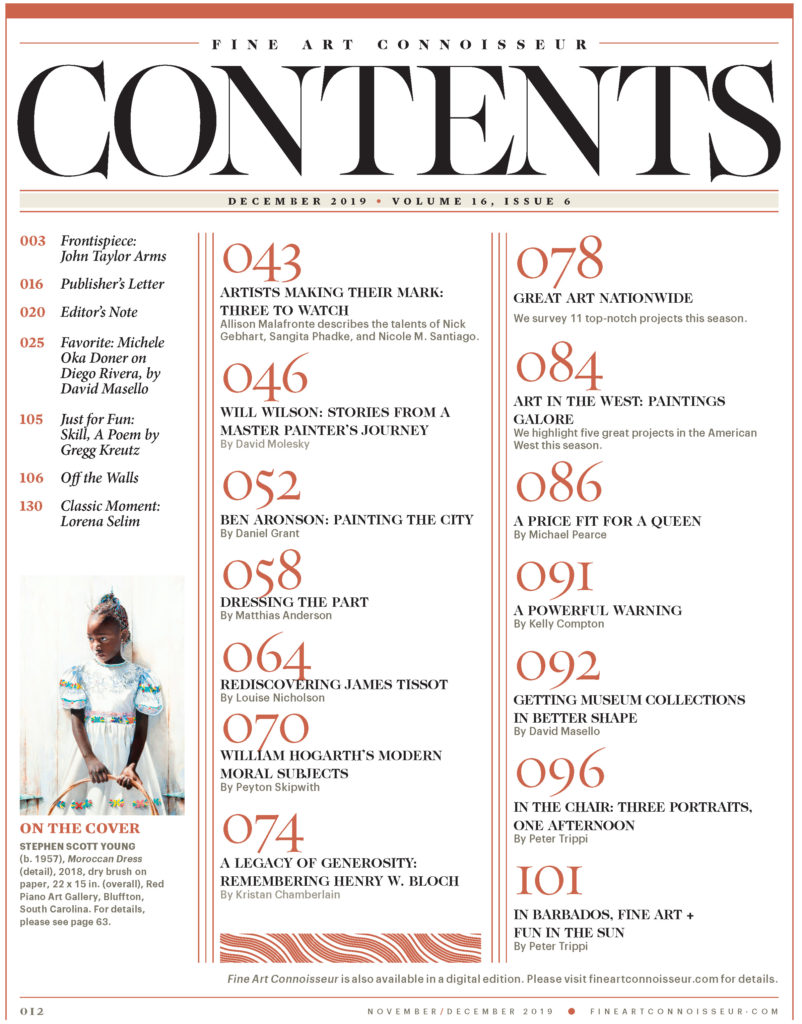
Fine Art Connoisseur November/December 2019, Editor’s Note:
Inspiration Abroad
I am writing this note from Marseille, France’s second largest city and a world away from Paris, even though a train ride there takes only three hours. A bustling port, Marseille is cleaner and richer than I recall it from my previous visit in 1987, so I have enjoyed getting reacquainted. The highlight of my stay came today, when I toured the extraordinary Centre Interdisciplinaire de Conservation et Restauration du Patrimoine (CICRP) with its enthusiastic director, Roland May.

This institution’s name translates to “Interdisciplinary Center for Conservation and Restoration of Cultural Heritage,” which offers a lot to unpack. Opened in 2002, CICRP is funded by a unique partnership of national, regional, and local agencies, and is the only such entity outside Paris. Its missions are to foster scientific research that helps professional colleagues worldwide take better care of artworks and buildings, and also to provide a place where paintings from across southern France can be restored to good physical condition.
Roland May kindly showed me the entire complex, a former tobacco factory that was built so sturdily a century ago that it was possible to upgrade it — two decades ago — into a state-of-the-art facility. Among its wonders are a series of high-ceilinged rooms where large paintings (including many church altar-pieces caked with candle soot) are cleaned in optimal conditions, a giant trap door that allows such massive works to be hoisted into position a floor above, and France’s largest conservation worktable — on which a huge painting can be laid out for treatment. This last room even has two rolling metal “bridges” that allow the conservators to hover over that table without actually touching it.
The treatments are undertaken by talented “freelance” conservators, but the CICRP is fully staffed with more than 20 professionals who focus entirely on the science of conservation in many materials. There are, for example, an entire unit devoted to fighting insect and fungal infestations, a studio with imaging equipment that can beam infrared, x-ray, or ultraviolet light onto an artwork to better understand its construction, and a laboratory focused on the distinctive challenges posed by stone (in sculptures or buildings).
Overseen by a board of advisers and re-approved for funding every five years, the center is able to get on with its work without external pressures. It pursues not only the “sexy” before-and-after conservation treatments we all love to admire, but also the slower research that gradually moves the entire field forward. These researchers publish their findings in professional journals and participate in conferences worldwide to explore new avenues.
Although the United States has large and outstanding laboratories in its major museums and at several universities that train future conservators, our country has nothing like the CICRP. It is unlikely one will emerge anytime soon — certainly not with government funding — but if there happens to be a billionaire out there who would like to make a difference that will truly endure, Marseille has the model to come study. Everyone’s precious cultural artifacts are better served when we understand what’s wrong with them and how they can be repaired or stabilized. For details, please visit cicrp.fr.
 Download the November/December 2019 issue here, or subscribe to Fine Art Connoisseur today so you never miss an issue.
Download the November/December 2019 issue here, or subscribe to Fine Art Connoisseur today so you never miss an issue.
Sign up to receive Fine Art Today, the free weekly e-newsletter from
Fine Art Connoisseur magazine.







